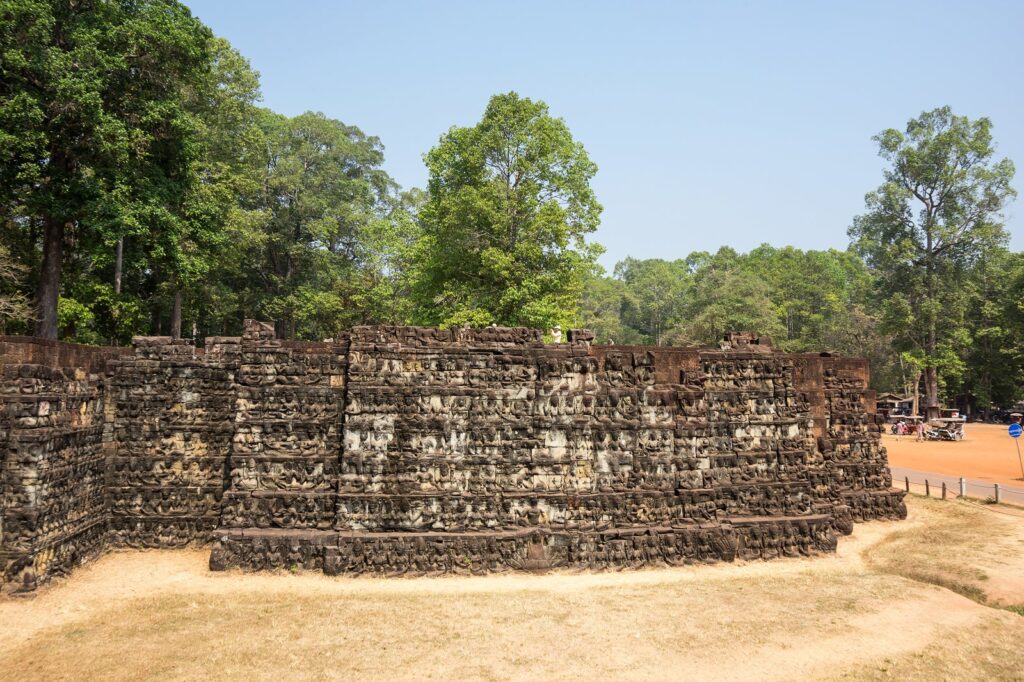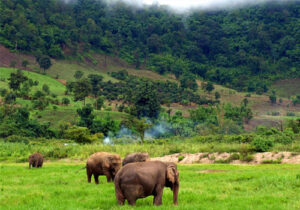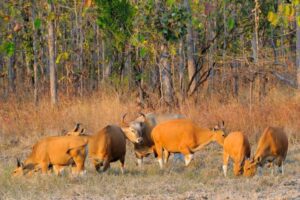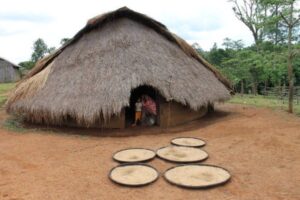
The stone monarch is absolutely naked, his hair is plaited and he sits in the Javanese fashion. The legs are too short for the torso, and the forms, much too founded, lack the strong protuberances of manly muscles; but, however glaring are his defects, he has many beauties, and as a study of character he is perhaps the masterpiece of Khmer sculpture. Whilst his body is at rest his soul boils within him…. His features are full of passion, with thick lips, energetic chin, full cheeks, aquiline nose and clear brow his mouth, slightly open, showing the teeth. This peculiarity of the teeth being shown in a smile is absolutely and strangely unique in Cambodian art.
Location: Immediately north of the Terrace of the Elephants
Access: From the main road
Date: End of the 12th century
King: Jayavarman VII (reigned 1181-1220)
Religion: Buddhist
Art style: Bayon
BACKGROUND
The Terrace of the Leper King carries on the theme of grandeur that characterizes the building during Jayavarman Vll’s reign. It is faced with dramatic bas-reliefs, both on the interior and exterior. During clearing, the EFEO found a second wall with bas-reliefs similar in composition to those of the outer wall. Some archaeologists believe that this second wall is evidence of a later addition to extend the terrace.
The original wall was only a metre-wide of laterite faced with sandstone. It collapsed and a second wall of the same materials, two metres wide, was built right in front of it without any of the rubble being cleared. Recently, the EFEO has created a false corridor which allows visitors to inspect the reliefs on the first wall.
LEPER KING
The curious name of this terrace refers to a statue of the Leper King that is on the platform of the terrace. The one you see today is a copy. The original is in the courtyard of the National Museum in Phnom Penh. The figure is depicted in a seated position with his right knee raised, a position some art historians consider to be Javanese-style. Its nakedness is unusual in Khmer art.
Who was the Leper King? Mystery and uncertainty surround the origin of the name. The long-held theory that Jayavarman VII was a leper and that is why he built so many hospitals throughout the empire has no historical support whatsoever.
Some historians think the figure represents Kubera, god of wealth, or Yasovarman I, both of whom were allegedly lepers. Another idea is based on an inscription that appears on the statue in characters of the 14th or 15th century which may be translated as the equivalent of the assessor of Yama, god of death or of judgment. Yet another theory suggests that the Leper King statue got its name because of the lichen 1 which grows on it. The position of the hand, now missing, also suggests it was holding something.
Cedes believes that most of the Khmer monuments were funerary temples and that the remains of kings were deposited there after cremation. He thinks, therefore, that the royal crematorium was located on the Terrace of the Leper King. The statue, then, represents the god of death and is properly situated on the terrace to serve this purpose. Yet another theory derives from a legend in a Cambodian chronicle that tells of a minister who refused to prostrate before the king, who hit him with his sword. Venomous spittle fell on the king, who then became a leper and was called I the Leper King thereafter.
LAYOUT
The Terrace of the Leper King is supported by a base 25 metres (92 feet) on each side and six metres (20 feet) in height. The sides of the laterite base are faced in sandstone and decorated with bas-reliefs divided into seven horizontal registers.
RELIEFS
Exterior wall: mythical beings – serpents, garudus and giants with multiple arms, carriers of swords and clubs, and seated women with naked torsos and triangular coiffures with small flaming discs – adorn the walls of the terrace. Interior wall: these reliefs are in remarkable condition. Walk along the corridor and enjoy a close up view of the deeply carved scenes arranged in registers. ‘The themes are similar to those on the exterior and include a low frieze of fish, elephants and the vertical representation of a river.





